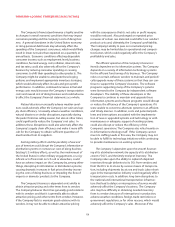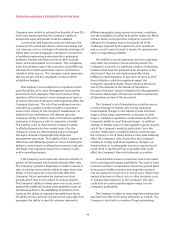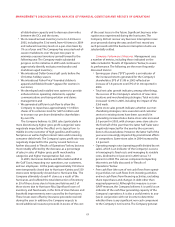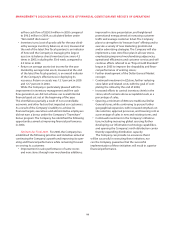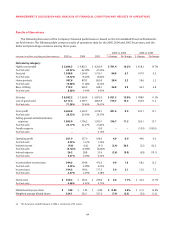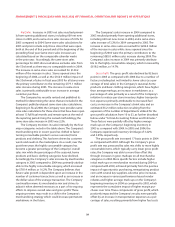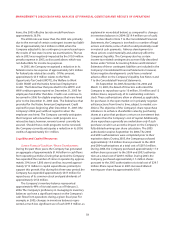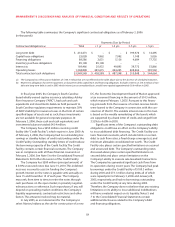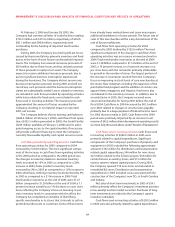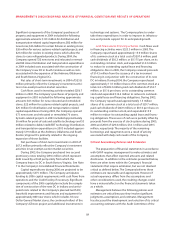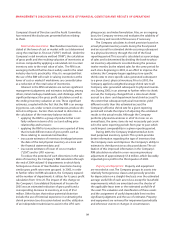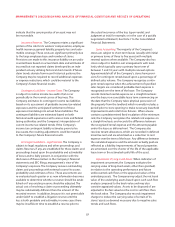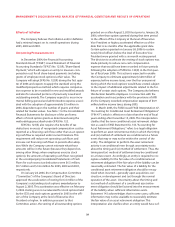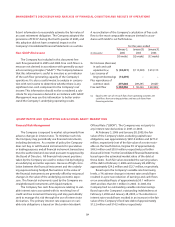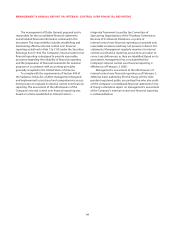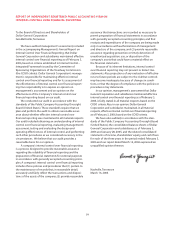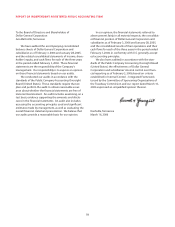Dollar General 2005 Annual Report Download - page 26
Download and view the complete annual report
Please find page 26 of the 2005 Dollar General annual report below. You can navigate through the pages in the report by either clicking on the pages listed below, or by using the keyword search tool below to find specific information within the annual report.
22
MANAGEMENT’S DISCUSSION AND ANALYSIS OF FINANCIAL CONDITION AND RESULTS OF OPERATIONS
items, the 2005 effective tax rate would have been
approximately 36.5%.
The 2004 rate was lower than the 2003 rate primarily
due to the reversal of certain contingent income tax liabili-
ties of approximately $6.2 million in 2004, when the
Company adjusted its tax contingency reserve based upon
the results of two state income tax examinations. The tax
rate in 2003 was negatively impacted by the $10.0 million
penalty expense in 2003, as discussed above, which was
not deductible for income tax purposes.
In 2005, the Company recognized a reduction in its
federal income tax expense of approximately $4.5 million
for federal jobs related tax credits. Of this amount,
approximately $3.9 million relates to the Work
Opportunity Tax Credit (WOTC), the Welfare to Work
Credit (WtW) and the Native American Employment
Credit. The federal law that provided for the WOTC and
WtW credit programs expired on December 31, 2005 for
employees hired after that date. Credits can continue to
be earned in 2006 for eligible employees that were hired
prior to the December 31, 2005 date. The federal law that
provided for the Native American Employment Credit
expired for years beginning after December 31, 2005 (the
Company’s 2006 year) without regard to when the
employee was hired. The Company currently anticipates
that Congress will renew these credit programs on a
retroactive basis; however, renewal cannot currently be
assured. Should these credit programs not be renewed,
the Company currently anticipates a reduction in its 2006
credits of approximately $3.1 million.
Liquidity and Capital Resources
Current Financial Condition / Recent Developments.
During the past three years, the Company has generated
an aggregate of approximately $1.46 billion in cash flows
from operating activities. During that period, the Company
has expanded the number of stores it operates by approxi-
mately 30% (over 1,800 stores) and has incurred approxi-
mately $713 million in capital expenditures, primarily to
support this growth. Also during this three-year period, the
Company has expended approximately $537 million for
repurchases of its common stock and paid dividends of
approximately $156 million.
The Company’s inventory balance represented
approximately 49% of its total assets as of February 3,
2006.The Company’s proficiency in managing its inventory
balances can have a significant impact on the Company’s
cash flows from operations during a given fiscal year. For
example, in 2005, changes in inventory balances repre-
sented a much less significant use of cash ($97.9 million, as
explained in more detail below), as compared to changes
in inventory balances in 2004 ($219.4 million use of cash).
As described in Note 7 to the Consolidated Financial
Statements, the Company is involved in a number of legal
actions and claims, some of which could potentially result
in material cash payments. Adverse developments in
those actions could materially and adversely affect the
Company’s liquidity. The Company also has certain
income tax-related contingencies as more fully described
below under “Critical Accounting Policies and Estimates”.
Estimates of these contingent liabilities are included in the
Company’s Consolidated Financial Statements. However,
future negative developments could have a material
adverse effect on the Company’s liquidity. See Notes 4 and
7 to the Consolidated Financial Statements.
On September 30, 2005, November 30, 2004 and
March 13, 2003, the Board of Directors authorized the
Company to repurchase up to 10 million, 10 million and 12
million shares, respectively, of its outstanding common
stock.These authorizations allow or allowed, as applicable,
for purchases in the open market or in privately negotiat-
ed transactions from time to time, subject to market con-
ditions.The objective of the Company’s share repurchase
initiative is to enhance shareholder value by purchasing
shares at a price that produces a return on investment that
is greater than the Company's cost of capital. Additionally,
share repurchases generally are undertaken only if such
purchases result in an accretive impact on the Company's
fully diluted earnings per share calculation. The 2005
authorization expires September 30, 2006. The 2004
and 2003 authorizations were completed prior to their
expiration dates. During 2005, the Company purchased
approximately 15.0 million shares pursuant to the 2005
and 2004 authorizations at a total cost of $297.6 million.
During 2004, the Company purchased approximately 11.0
million shares pursuant to the 2004 and 2003 authoriza-
tions at a total cost of $209.3 million. During 2003, the
Company purchased approximately 1.5 million shares
pursuant to the 2003 authorization at a total cost of $29.7
million. Share repurchases in 2005 increased diluted
earnings per share by approximately $0.01.



